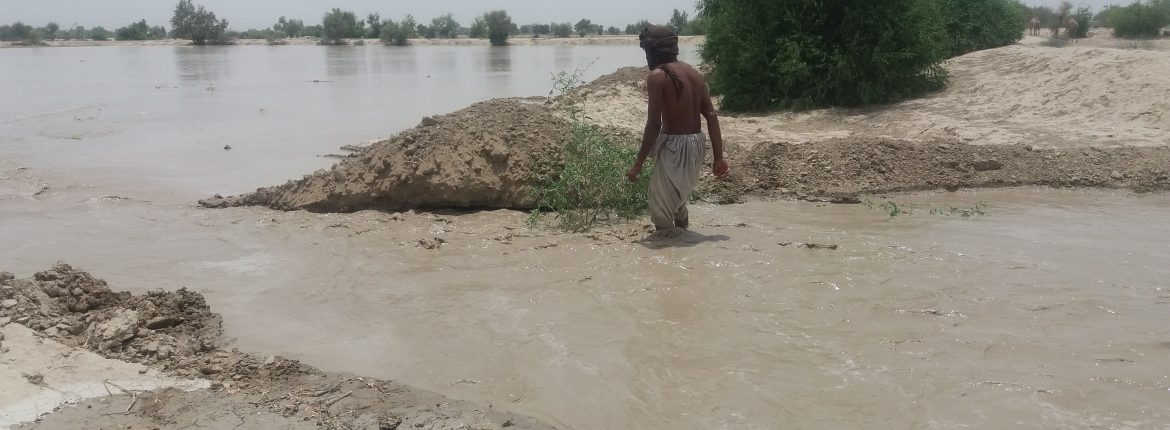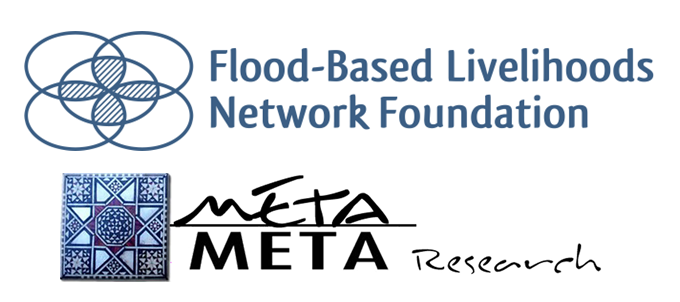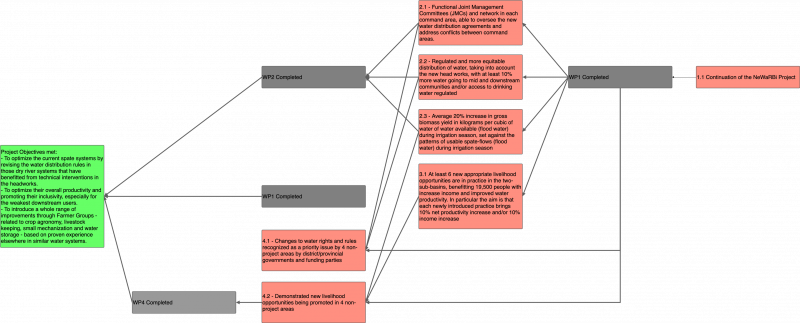

Introduction
Spate irrigation is a unique water resource system that makes productive use of short duration floods in dry river beds. It is common in Pakistan, covering an area of 1 Million ha . The Newarbi project aims to optimize the current spate systems by revising the water distribution rules in those dry river systems that have benefited from technical interventions in the headworks. It is envisioned that the systems are brought up to date after changes made to main headworks and resource use, thereby optimizing their overall productivity and promoting their inclusivity, especially for the weakest downstream users. In addition a whole range of improvements – related to crop agronomy, livestock keeping, small mechanization and water storage, based on proven experiences elsewhere in similar water systems will be introduced through farmer groups.
Project summary
The project aims to contribute towards the re-setting of water distribution rules in target command areas, thereby promoting efficient water use in agriculture for better livelihood opportunities. It requires a range of activities, including training, capacity building, empowerment of the weakest stakeholders, lobby and advocacy at the district level, and command area infrastructure development. There is a need for a good mix of expertise related to both social change processes and concrete action in the field of water management rules and regulations and improved practices. This requires a partnership of organisations that each offer their own specific value for the actions to be made in Pakistan.
The project is jointly carried out by:
- MetaMeta Research – lead organisation
- Strengthening Participatory Organisation (SPO) – project partner Balochistan
- Research and Development Foundation (RDF) – project partner Sindh
- Sindh Irrigation and Drainage Authority (SIDA)
- Irrigation Department, Government of Balochistan Province, Pakistan and
- Sustainable Water Fund of the Netherlands Enterprise Agency (RVO) – funding partner
Project outcomes
The project is built around three themes and for each theme a number of outcomes have been defined:
- Improved and equitable utilization of productive floodwater (Work Package 2)
- Functional Joint Management Committee (JMCs) and network in each command area, able to oversee the new water distribution agreements and address conflicts between command areas
- Regulated and more equitable distribution of water, taking into account the new head works, with at least 10% more water going to mid and downstream communities and/or access to drinking water regulated.
- Average 20% increase in gross biomass yield in kilograms per cubic meter of water of water available (flood water) during irrigation season, set against the patterns of useable spate-flows (flood water) during irrigation season
- New livelihood opportunities through improved land and water management practices (Work Package 3)
- At least 6 new appropriate livelihood opportunities are in practice in the two sub-basins, benefitting 19,500 people with increased income and improved water productivity. In particular the aim is that each newly introduced practices brings 10% net productivity increase and/or 10% net income increase.
- Out scaling and dissemination of recalibrated water distribution rules and livelihood opportunities (Work Package 4)
- Changes to water rights and rules recognized as a priority issue by 4 non-project areas by district/provincial governments and funding parties.
- Demonstrated new livelihood opportunities being promoted in 4 non-project areas
Theory of Change
The project logic has been drafted into a Theory of Change. The schematic presentation of the Theory of Change can be downloaded here.
- Theory of Change (summary / total)
- Work Package 1
- Work Package 2
- Work Package 3 (a / b)
- Work Package 4 (a / b)
- Work Package 5
Resources
Blogs
- Blog – From Flood to Field: Organized Farmers in Naj Gaj, Sindh
- Blog – Preparing for the Monsoon in Pakistan: Urban Flooding, Deluges, and Planning
- Blog – Manganhars: the Beacons of Happiness
- Blog – Pastoralism in Balochistan: a quick insight
- Blog – The Much-Needed Reversal: Nature-Based Solutions for Rangeland Management in Balochistan, Pakistan
- Blog – First Chickpeas
- Blog – The Sounwah FLood Guide Bund: a remarkable stody of resilience
- Blog – From Dam to Damage in Balochistan
- Blog – Flood Evacuations: Tough Realities
- Blog – Understanding why Sindh Faces Frequent Flooding: Insights from a Provincial Consultative Dialogue
- Blog – Mud over Iron: Grain Storage in Spate Irrigated Areas
- Blog – Flood Resilience and Spatial Planning in Pakistan: Where are we two years after the devastating flood?
- Blog – Understanding why Sindh Faces Frequent Flooding: Insights from a Provincial Consultative Dialogue
- Blog – Livestock and climate change: resilient cattle sheds
- Blog – We After The Flood: assessing the response to the 2022 floods in Balochistan, Pakistan
- Blog – Baluchistan running dry
- Blog – Flood resilience: converting opportunity at the fringes
- Blog – Enhancing Micronutrients levels in Crops: Promising Results from Chickpea Iron and Zinc Spray Trial in Baluchistan
- Blog – A flood with a benefit: using the extensive moisture in Kachhi Plains
- Blog – Flood-proofing the road network (4): Roads for water, safe flood water drainage, bridges, and causeways
- Blog – Water wonders of the world the mysterious gabarbands
- Blog – Flood-proofing the road network (3): roads for upland water retention in Pakistan
- Blog – Flood-proofing the road network (2): roads for controlled drainage in Pakistan
- Blog – Flood-proofing the road network (1): roads as flood shelters in Pakistan
- Blog – Laths – key to rebuilding livelihoods after the floods in spate irrigation
- Blog – Salvaging the rabi crop in the spate irrigated areas of Pakistan
- Blog – Hill Torrent Floods Impacting the Southern Punjab Pakistan
- Blog – Pakistan: Flooded Once Again
- Blog – Pastoral frontiers in Balochistan
- Blog – Access to drinking water in spate irrigation areas with small technology
- Blog – At the heart of Water Governance: Adjusting Water Allocation
- Blog – Drinking Water Ponds in the Kacchi Plains (Bhag Nari, Balochistan)
- Blog – A year in spate irrigation: floods as blessings, rain as a problem
- Blog – Symbiosis: Pastoralists and Farmers in Balochistan
- Blog – Farmer to Farmer Knowledge Transfer
- Blog – Locust Outbreaks in Sindh, Pakistan
- Blog – Lockdown Reality Check in Sindh
- Blog – New Local Energy: Solar Mini-Mills
- Blog – Lockdowns in rural Pakistan – What to do
- Blog – Effect of dam construction on underground flows in Jamshoro, Pakistan
- Blog – Locust threat averted in Sindh, Pakistan
- Blog – The power of networking and opportunity analysis in times of COVID-19
Video
- Video – Diverting a Rising Flood in Naj Gaj
- Video – Low cost shallow wells for drinking water for flood victims in Balochistan, Pakistan
- Video – Flood damage in Kacchi Plains, Balochistan, Pakistan
- Video – Flood utilization and flood protection in Bhag Nari, Balochistan (Pakistan)
- Video – Crop production in Hill torrent areas of Pakistan (English)
- Video – Crop production in Hill torrent areas of Pakistan (Urdu)
- Video – Locust Outbreaks in Sindh, Pakistan (Aftab Akhund, RDF Pakistan)
- Video – Aragula Harvest and processing in Bhag Nari, Pakistan, 2021
- Video – Improving Dikes in Bhag Narri spate systems
- Video – Headworks at Sidi in Nari River
- Video – Harvest-time Charity in Pakistan
- Video – Farmer rehabilitaton Balochistan
- Video – Bagh, Pakistan- A Pond Runs Dry
- Video – Aragula (rucola) Harvest
- Video – Flood Water Management in Bhaag – Kachi Balochistan, Pakistan
- Video – Grafting of Jujube Tree
Latest video (Oct 2022): Low cost shallow wells for drinking water for flood victims in Balochistan, Pakistan
Podcast
- Pakistan Floods (Sep 2022), available on:
- Spotify: https://tinyurl.com/mtceht7w
- Apple Podcast: https://tinyurl.com/yp29svsc
- Google Podcasts: https://tinyurl.com/mrxrhdr6
- Anchor FM: https://anchor.fm/twc-podcast/episodes/Understanding-Pakistan-Floods-e1ojqvr
- Podcast by NRC (Newspaper from The Netherlands) on how Johi (Dadu district) was saved by building a dike around the village (in Dutch).
Project updates
- Febuary 2021
- October 2021
- March 2022
- June 2022
- September 2022
- November 2022
- March 2023
- June 2023
- September 2023
- November 2023
- February 2024
- May 2024
- September 2024
- June 2025
Flood assessment reports (August/September 2022)
Other
- Livelihoods Brochure (English / Sindhi)
- Spate Irrigation Brochure (brochure)
- Photobook – Spate irrigation in practice and pictures
- Project website on RVO’s M&E platform (website)
- ‘Fair Spate Irrigation from the Source‘, article on the project as part of the newsletter of the Sustainable Water Fund, July 2022 (newsletter)
- Health and Hygiene – Training Manual (Urdu)
- Homestead Poultry Keeping Manual (English)
- Organic Guar Value Chain Report
- Overview Paper
- 18 – Spate Irrigation in Nai Gaj, Pakistan: Status and Potential (English)
- Practical Notes
- 29 – Improvements in the Design of Flood Diversion Structures (English)
- 34 – Study on the Ecosystem of the Kachi Plain with Focus on Spate Irrigated Areas of Bhag Narri, Balochistan – Pakistan (English)
- 38 – The Use of Trees and Shrubs in Spate Irrigation Areas (English)
- 40 – Usage of Wild Trees on Private Farm Land in Spate Irrigated Areas (English)
- 41 – Local Vegetable Production in Spate Irrigated Areas, Experiences from The Kachi Plain Flood Irrigated System in Pakistan (English)
- 42 – Improved Field Water Management in Spate Irrigation (English)
- Presentations:
- Presentation to FDW community on scaling of the approach (presentation) – 30 September 2021
- Presentation to FDW community on floods (presentation) – 27 September 2022
- Presentation during 2023 Pakistan Water Week on ‘Management of Hill Torrents: Opportunities and Challenges –
Untapped Potential of Spate Irrigation in Pakistan’ (presentation) – 5 December 2023 - Presentation during 2023 Pakistan Water Week on ‘Towards local and system flood resilience: turning threats into opportunities’ (presentation) – 4 November 2024
- Policy documents contributed to:


